The First Season: Week 1
The NAFL’s first-ever game was played on Sunday, March 3, 1895, between Brooklyn Wanderers and Centreville AC at the Varuna Boat Club grounds in Bay Ridge, South Brooklyn. Defying the New York Daily Tribune’s prediction, Centreville AC had little problem disposing of the Wanderers 5-2, with goals by Frederick Oliver (2), George Spaven, John Coupar, and John Grundy. Mason and Young tallied goals in defeat for the Wanderers. Newspaper accounts described ground conditions ranging from “heavy” to a “sea of mud,” but a fast game was played nonetheless.[1] Brooklyn were “deprived of their regular goal keeper through an accident, and thus handicapped.”[2] The Brooklyn Daily Standard Union praised the Centreville back line with “Wilson particularly distinguishing himself by the manner in which he always sent the ball flying across the field.”[3] (View PDF of box scores for all matches completed in the first NAFL season.)
The second game scheduled for March 3 between the Scottish-Americans and the Americus AA at Newark did not take place; not only could the clubs not agree whether the grounds were fit to be played on, referee James Conners did not show up for the contest. Not a good start for the new league.

An uneventful mid-week league meeting took place on March 5 at the Cricketers’ Club on 108 West Twelfth Street. All clubs sent delegates except New Rochelle. The first order of business was to address the Scottish-American – Americus AA fiasco, where “a long discussion leading to nothing took place as to why the game was not played and it was at length agreed to call it a postponed game and have it played May 12 at Newark.”[4] Whitworth Southern and the other delegates could be forgiven if they were losing confidence in the New Rochelle organization since the no-show referee was also a delegate of the club.
Week 2
Week two action called for a Saturday, March 9, matchup in Newark between Scottish-Americans and New Rochelle, and a Sunday meeting in West Hoboken between Americus AA and Brooklyn Wanderers. Referees assigned for the games included J. A. Young of Brooklyn Wanderers for the game at Newark and A. Henderson of Centreville AC for the Brooklyn Wanderers Sunday contest at West Hoboken.
Showing obvious growing pains, the games during the second week were no more successful than the first when New Rochelle again failed to meet their league commitments and did not appear at the Scottish Americans’ grounds in Newark. With the no-show, the New York Sun reported that referee P. Fisk of Americus AA called the game in favor of the Scots.[5]
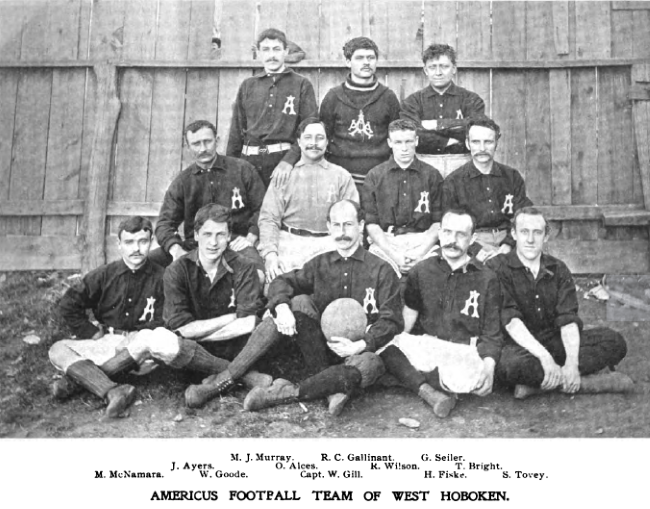
The NAFL Executive Committee held its weekly meeting on Friday, March 15 at the Cricketers Club, with the usual delegates attending. A troubling pattern was emerging: teams, and referees for that matter, had difficulty fulfilling commitments to away contests. Travel had long been an impediment to regional sports leagues during this period, but the proximity of the teams involved in the NAFL seemingly mitigated this problem. The New York Sun reported that the non-appearance of the New Rochelle club and subsequent referee decision in favor of the Scottish-Americans resulted in a long discussion between Executive Committee members, “but the decision of the referee in awarding the game to the Scottish-Americans was upheld.” The report further stated, “the defaulting club is down to play the Centreville AC today [March 16] at Bayonne and great doubt was expressed as to the probability of the contest taking place.” Fisk was appointed referee of the New Rochelle – Centreville match. The league sent a stern warning in announcing Fisk was “on hand to award the game to the club ready to start in case either team should fail to show up.”[6] However troubling these early results may have been, the Brooklyn Daily Eagle reported that the “games are attracting a great deal of attention.”[7]
Centreville AC kept busy during their bye week with a goalless draw against the International Steamship Company Athletic Club. Fifteen hundred spectators witnessed the friendly, which the Bayonne Times reported was dominated by Centreville.[8]
Week 3
Week 3 featured two matches, Centreville AC vs. New Rochelle on March 16, and Brooklyn Wanderers vs. Newark Scottish-Americans on Sunday, March 17.
The Centreville-New Rochelle was a Saturday fixture, as requested by the New Rochelle management during their negotiations with NAFL officials. But once again, the New Rochelle club did not appear to meet its opponent and Fisk, the appointed referee, awarded the game and the two points to Centreville.
Centreville apparently prepared for the New Rochelle no-show and scheduled a non-NAFL game that Sunday with International AC of New York. Centreville won the contest against the future NAFL member by the score of 2-1.[9]
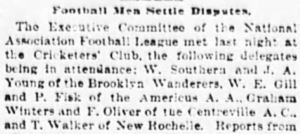
The weekly meeting of the NAFL Executive Committee took place on Friday, March 22 at the Cricketer’s Club with representatives from all five clubs attending. The official referee reports were read and accepted, “and the failure of the New Rochelle team to keep its engagement with the Centrevilles resulted in the latter receiving two points.”[10] New Rochelle alerted the Brooklyn Wanderers of their inability to play the upcoming March 23 fixture and the Wanderers were awarded the victory at the meeting. The New York Daily Tribune reported that the New Rochelle club “was given a week to decide whether they could keep further engagements” and the New York Sun added that “it is probable that the New Rochelles will resign from the league, and it is understood that they will be dropped anyway if they disappoint any more clubs.”[11]
The Sun added commentary on the financial status of the league from treasurer Gill:
The Treasurer reported that the attendance at all games played so far had been good and that there was a comfortable balance in the treasury. With improved weather and the best contests yet to be played, it is expected that the funds in hand will be ample to meet all expenses, including a silver cup to the winning club, gold medals to the champion team, and silver medals to the runners-up.[12]
Week 4
With the New Rochelle vs. Brooklyn Wanderers match already in the books, the remaining Week 4 game featured a Sunday, March 24, contest between Americus and Centreville in West Hoboken at the Americus grounds. Playing in front of a “fair-sized crowd” during a “steady drizzle,” Centreville had an easy time disposing of the Americus eleven by the score of 9-1.[13] Although both the Bayonne Times and the New York Sun reported a score of 8-1 in the game recap, the goal totals in the game summary indicate a total of 9 goals were scored by Centreville. Grundy of Centreville was the individual star, scoring a hat-trick, while Campbell, Spaven, and Coupar secured braces. Ohmar scored the lone goal for the home side.
The league’s weekly meeting took place on Friday, March 29 at the Cricketer’s Club. Still lacking a resolution to the New Rochelle problem, Southern and the other NAFL executives either contacted or were approached by the Jefferson Football Club of Newark. Jefferson, early supporters of the league, were unable to commit and had removed themselves from consideration at the January 15 league meeting. The New York Sun reported that the Jeffersons had “made application for membership to be admitted on the same footing as the New Rochelle Club, playing Saturday games. There appeared to be a strong objection to playing any more Saturday games, and it is probable if the club is admitted it will have to play on Sundays. They were invited to send a representative to the next meeting of the league when their application will be acted upon.”[14]
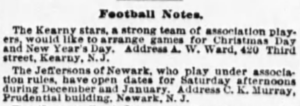
Managed by C.K. Murray, Jefferson had been playing friendly contests in the NJ/NY area, even posting an announcement in the December 1894 New York Sun looking for Saturday afternoon games.[15] Murray was a well-known early supporter of soccer and cricket in the area and was regarded highly enough to contribute “History and Progress of the American Football Association” to the 1910 Spalding Guide. Murray, who listed the Newark Prudential Building as his contact address for all soccer-related matters, played for the Brooklyn Wanderers and would later go on to manage the Newark Football Club (1895) and the Newark Scottish-Americans (1904), before becoming vice president of the Metropolitan Association Football League in 1905.
The Brooklyn Wanderers also proposed a revision of the schedule to add additional games if the league was to carry on as a four-team circuit. This proposal was initially objected to by Centreville, “but the matter was left over to the next meeting when the delegates will come prepared to act, with instructions from their clubs.”[16]
Week 5
Week 5 featured two matches, New Rochelle vs. Americus on Saturday, March 30, and Newark Scottish-Americans vs. Centreville AC on Sunday, March 31. The Scots – Centreville match was the only one to take place as the New Rochelle club was, at this point, only a meeting away from suspension or outright dismissal.
Before a large crowd, the Scottish-Americans, featuring a significantly enhanced lineup, rolled to a 4-2 victory against Centreville at Wiedenmayer’s Park, Newark. The New York Sun referred to the match as “by far the best contested and most interesting game in the championship series of the National Association Football League.”[17] Wallace scored a brace for the Scots, who also featured goals from Higgins and a new man Singleton. Grundy scored his fifth goal of the season for Centreville, who also registered a goal from J. Spaven.
McGee, Singleton, and Cutler – the new men for the Scots – were well-known Kearny-area players who had previously played for the Kearny Unions, also known as the Newark club in the professional AAPF circuit which operated several months prior. The inclusion of these three players in the Scots lineup reflected a common practice of the day: top players often moved between various clubs seeking the best financial situation. These three players would feature for several top NAFL teams in the coming years. The inclusion of these former AAPF players in an NAFL contest underscored that the AAPF, which had hoped for a spring season to commence at the end of March, had ceased operations.
The NAFL marked the first time eastern soccer fans would hear the name of John (Jack) Grundy. Correspondence with his great-grandson Steve Grundy reveals that John Grundy was born on January 23, 1874, in Bolton, Lancashire, England, and emigrated to America in June of 1894.[18] Grundy would emerge as a prominent player during the first edition of the NAFL before shining brightly as an administrator in the early decades of the 1900s. As the manager of the Jersey City Athletic Club soccer team, he won a NAFL title during the 1910-1911 season and brought home two second-place finishes. Grundy also led the Skeeters to the quarter- and semi-finals of the AFA Cup tournament. Off the field, he served on committees supporting the AFA and also served as NAFL President in 1912. Perhaps his greatest achievement was participating in activities supporting the founding of the United States Football Association as a representative for the New Jersey State Football Association.[19]
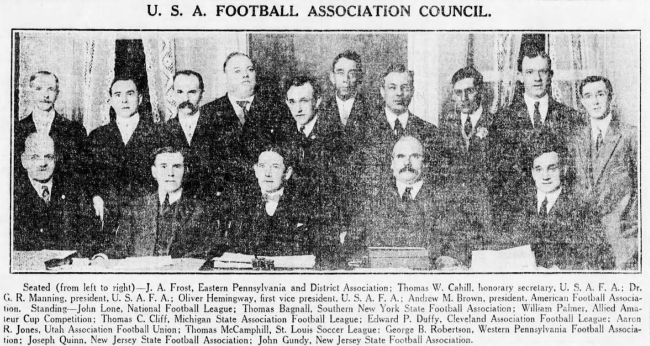
Week 6
Week 6 was the first week where both scheduled league contests were fulfilled, with Americus AA hosting Scottish-Americans and Centreville AC meeting Brooklyn Wanderers. Both contests were played on Sunday, April 7. With the winter weather coming to a close and important league contests approaching, the New York Herald reported “the championship contests of the National Association Football League are drawing out considerable interest in the ‘dribbling code.’”[20]
The Newark Evening News also included coverage of the non-NAFL contest on Saturday between Kearny Unions and Newark Caledonians. Swithenby and Spencer featured for the Caledonians, while Singleton and McGee suited up for the Unions. Alf Cutler, missing from the lineup for the Scottish-Americans’ NAFL contest, also missed the game for the Unions. The Newark Evening News declared that “Cutler, of the Unions, considered one of the strongest men on the team, was unable to play owing to a sprained ankle, and the losers declared they were badly handicapped by his absence.”[21] These players, some of the finest in the Newark/Kearny area and instrumental to the Caledonians’ AFA Cup prospects, were now participating in NAFL contests. The Sunday schedule adopted by the NAFL allowed for these players to play Sunday for NAFL teams while keeping Saturday schedules with teams such as the Unions and Caledonians.
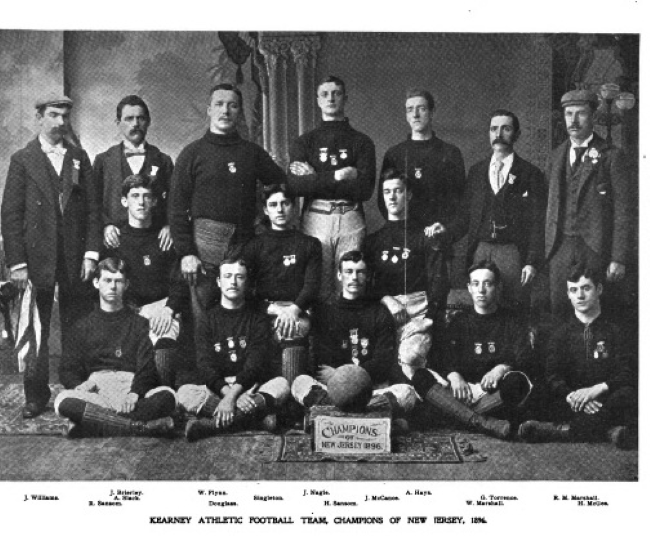
The Bayonne Times reported the Centreville AC – Brooklyn Wanderers contest was won 5-2 by Centerville, with George Spaven, Coupar, Oliver, and Grundy as goal scorers.[22] The New York Sun, however, reported a different scoreline: “The reports of the other referees were received, showing that the Centreville AC defeated the Brooklyn Wanderers last Sunday by four goals to two.” This essay assumes the 4-2 scoreline reported at the meeting, with the goal scorers matching the Bayonne Times game report.
The NAFL Executive Committee held its weekly meeting on April 13 at the Cricketers Club. The meeting proved to be a lively affair, with two protests received. The first protest came from Centreville AC for their March 31 game with the Scottish-Americans, on account of spectators encroaching on the field of play. The second protest was lodged by Americus AA regarding their April 7 contest with the Scottish Americans, but no reason for the protest was included in newspaper accounts. Neither protest was successful, however, as the NAFL rules gave the referee full power and authority the referee’s decision was “final, and, even if he makes a mistake, it must stand.[24]
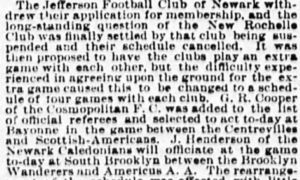
More important, the idea of Saturday soccer for the NAFL was finally put to rest at the meeting with the suspension of the New Rochelle club and the cancellation of their schedule. The Jefferson Football Club of Newark, who applied for league membership the previous week and were also hopeful of a Saturday schedule, formally withdrew their application. The NAFL was now down to the four teams that would compete for league honors and the schedule was rearranged so that each club would play an additional eight games. An extra contest between the Scottish-Americans and Americus AA was also added so that each team would finish the season with thirteen games played, five more than called for in the original schedule published on January 30.[25] The adjusted schedule was adopted, according to the New York Sun, “with little difficulty.”[26]
Week 7
With a new schedule adopted featuring only Sunday games, Week 7 found the Scottish-Americans traveling to Bayonne to face Centreville AC and Brooklyn Wanderers hosting Americus at their facility in South Brooklyn. Both contests were played on Sunday, April 14.
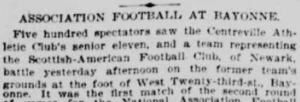
In what the New York Daily Tribune called the “first match in the second round of games for the National Association Football League’s championship,” 500 spectators watched as Centreville defeated the Scottish-Americans by the score of 4-2 on the Centreville grounds “at the foot of West Twenty-third Street, Bayonne.”[27] J. Campbell scored a brace for Centreville, with F. Oliver and G. Spaven accounting for the other two goals. McCullough and McDonald scored for the Scots.[28] Centreville put the game out of reach early with four first-half goals to one for the Newark club. Centreville kept up the pressure in the second half and “kicked two other palpable goals, but Referee J. Young of the Brooklyn Wanderer’s Football Club would not allow the count either time.”[29] View box score and team lineups.
Over in Brooklyn, the Americus Athletic Association club won their first non-forfeit game of the season with a hard-fought 2-1 victory over Brooklyn Wanderers. The New York Times reported, “the game was warmly contested by both sides, and ‘fouls’ predominated: but it was fast and even, and was well enjoyed by a large crowd.”[30] The New York Sun noted the fine play of Americus defender W. Flynn, who “alone prevented [Brooklyn Wanderers] from scoring on several occasions by the most daring play.” The performance of Brooklyn player Retlas was also mentioned, but the loss of center halfback Stubbs affected Brooklyn’s play. Taylor knocked in two for Americus while Mason scored the lone tally for Brooklyn.[31]
The league’s weekly meeting took place on Friday, April 19, at the Cricketer’s Club. Like the last session, the event was a lively affair that “lasted until almost midnight.” With the season in its latter stages, the weekly meetings were becoming more hotly contested. The New York Daily Tribune reported, “Protests seemed to be the order of the evening, and several animated discussions took place regarding the play of several men, and the decisions or alleged incompetency of some of the referees.” The Tribune oddly mentioned, “the sense of the meeting was against the practice of the backs handling the ball.” [32]
League treasurer Gill reported positive news regarding the financial health of the fledgling league, with the sizable attendance at league games increasing league coffers by a considerable amount. The league was in such good fiscal shape that “the secretary and treasurer appointed a committee to purchase a silver cup, which will be presented to the leading club.” In addition, eleven gold medals were purchased by Young and Gill for the winning club and eleven silver medals for the runners-up. After considerable early-season struggles, the NAFL was finally on solid ground.
Week 8

Week 8 featured an April 21 match in Bayonne between the league-leading Centreville and the last-place Americus. The match was a one-sided affair, with Centerville adding “another victory to its already long list” by trouncing the visitors by the score of 12 goals to 0. The Jersey City News provided the lineups for each team and oddly listed “Sub” for three Americus forward positions. The Bayonne Times clarified the situation by stating the Americus club fielded only eight players for this contest. [33] Coupar scored four goals for the Centrevilles, while Winters and Campbell each chipped in with two. Spaven, Oliver, Gorevin, and Grundy completed the scoring for Bayonne.

The Americus club did not take the drubbing lightly. During their annual meeting held three days after the defeat, the club decided to “continue membership in the National Association Football League and play out the championship schedule.” This indicates the club, whose motto was “sport for sport’s sake,” may have seriously considered resigning from the league in the days leading up to the meeting. Fortunately, the club indicated “several prominent players have signified their intention of being with the team in the future, and it is expected that a better game can be put up.”[34] W. E. Gill, treasurer of the NAFL, was elected president of the Americus club, while NAFL delegates T. Bright (secretary and manager) and F. Davis (Executive Committee member) were also elected. This difficult period for Americus undoubtedly reinforced Gill’s negative views of league play.
In the battle for second place, a large crowd in Newark witnessed an entertaining victory by Brooklyn over the Scottish-Americans by the score of 6-4. The Wanderers started the game with only nine men and the Scots immediately capitalized by scoring two goals in the first five minutes. Once the Wanderers reached full strength after the late arrival of two players, they surprisingly had the best of the play. The Wanderers were “considerably strengthened by the addition of Jack Jones and J. Taylor of the steamship Majestic,” which may have accounted for their newfound quality.[35] Gemmill was the offensive star for the Wanderers with three goals, and on the defensive side “the play of Patrick at full back was a feature of the game.”[36]
In non-NAFL news, local papers included coverage of the semi-final AFA cup tie between the Paterson True Blues and the Newark Caledonians at Cosmopolitan Park, East Newark. The Blues were winners by the score of 4-2 in what one Paterson newspaper called “the greatest game and the best football attraction ever placed before the public of New Jersey.”[37] In the lineup for the Caledonians were players Dawson, McCance, and McDonald who featured for the Scottish-Americans in recent NAFL contests.
Week 9
Week 9 featured two April 18, 1895, contests, with the resurgent Brooklyn Wanderers hosting the league-leading Centreville in South Brooklyn, and the Scottish-Americans taking on Americus AA at Wiedenmayer’s Park in Newark.

In what the New York Times described as a “very interesting game,” Centreville defeated the Brooklyn Wanderers by the score of 5-4. Brooklyn showed a much better product on this day than the 5-2 drubbing they received on opening day from Centreville. Although the Brooklyn aggregation had “the best of the game…aggressive play toward the end of the second half” won Centreville a “well-earned victory.”[38] George Spaven, James Campbell, Frederick Oliver (2), and Jack Coupar scored for the victors while Allen (2), Mason, and Brown tallied for Brooklyn. Allen of Wanderers and Graham Winters of Centreville were the Times’ men of the match.[39] Jones and Taylor of the steamship Majestic, conspicuous in the prior week’s contest, were not in the Brooklyn lineup.
The second game featured the Scottish-Americans defeating Americus by the score of 3-1. The New York Times referred to the Americus squad as a “much-improved team,” but the Scots ultimately triumphed in this “rather slow but evenly-contested” affair.[40] A heavy wind made this a true “game of two halves,” with the Scots having a decisive edge in the first stanza and the Americus eleven dominating the second. Americus pressed the Scots heavily in the second half, but the Scots were able to hold on to their early lead. Hill, Wallace, and McGee scored for the Scots, while Brown tallied for Americus.
Week 10
The Week 10 contest on May 15, between Brooklyn Wanderers and Scottish-Americans at Wiedenmayer’s Park was another high-scoring affair, with each club scoring four goals. By now most newspapers were devoting more space to covering spring pastimes such as the start of the new baseball season and coverage of the game was sparse and goal scorers for the contest were not recorded. The Newark Evening News, however, covered the game and also mentioned the Scottish-Americans would conduct their annual meeting on May 9 to elect officers for the following year.[41]
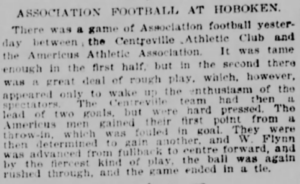
The second May 15 fixture featured Americus against Centreville at West Hoboken. The Americus squad recovered nicely from the 12-0 drubbing administered by Centreville on April 21, forcing a 2-2 draw with the league leaders. The game was a physical contest, with Americus goalkeeper Oscar Alces being “ordered off the field” by referee Roderick McDonald for rough play.[42] Grundy and Coupar scored for Centreville, while Flynn scored one goal for Americus. Oddly, the Sun’s description of the Americus goal scorers includes “Coupar’s foul and Flynn for Americus.” Was the goal due to “Coupar’s foul” an own goal? Most likely that was not the case. The laws of the game published by the American Football Association in 1888, Law 4, stated that “Should any player willfully foul the ball in such way as to prevent the scoring of a goal, the Umpires and Referee may decide that a goal has actually been obtained by the side thus prevented from scoring.”[43] This rule was most likely in place during the inaugural season of the NAFL and is probably the explanation for awarding a goal for the foul by Coupar. The NAFL later adopted the penalty kick rule during the 1895-1896 season.
Week 11
The New York Daily Tribune introduced the week 11 results by commenting that “the contest for the cup is rapidly drawing to a close and each club is now striving hard for every point obtainable.” The extension of the season into May and June caused the Newark Sunday Call to refer to the games as “Hot Weather Football.”[44]
The May 12, 1895, Brooklyn Wanderers – Americus contest was held in front of a “good-sized crowd at Americus Park, West Hoboken” and the Wanderers “proved the stronger eleven” by the score of 3-1.[45] The Americus squad was bolstered by the inclusion of Jamieson, Pennycook, and Higgins, well-known players from the International Athletic Club football team of New York. Pennycook and Higgins had been members of the New York team in the short-lived ALPF, and Pennycook was an Americus player back in the days of the AAFL in 1894.[46] The New York Daily Tribune remarked, “Gemmill, McGuire, and McConnell did the best work for the winners, and Taylor worked hard for the Americus.”[47]

In the second May 12 contest, the Scottish-American were defeated by league-leading Centreville at Wiedenmayer’s Park by the score of 4-1.[48] The four Centreville goals were scored by George Spaven, Frederick Oliver, John Grundy, and Jack Coupar.[49]
Week 12
Week 12 games, played on May 19, 1895, featured Centreville against Brooklyn Wanderers and the Scottish-Americans against Americus. As the title race progressed, it was evident Centreville was the class of the league and the remaining three clubs would slug it out for the remaining positions. Adding to the drama, late-season roster changes were becoming commonplace, adding an air of uncertainty to each Sunday’s contests.
Centreville defeated Brooklyn Wanderers by the score of 6-3 in Bayonne. Brooklyn’s attack followed a recent trend: stalwarts Gemmill and Mason accompanied by a piecemeal set of running mates to assist them. Luckily, Brooklyn’s lineup again contained Jack Jones of the steamship Majestic, who scored two of Brooklyn’s goals. Allen of the Wanderers, the New York Times’ man-of-the-match for Brooklyn the last time these teams met, was absent. Centreville, however, took the field with nine of the eleven players who participated in the 5-4 victory administered against the Wanderers on April 28. This consistency in the Centreville lineup no doubt played a role in the team’s inaugural NAFL season success. Frederick Oliver and Jack Grundy scored a brace for the league leaders, as did Frederick Oliver, his fifth and sixth goals against the Wanderers in the season.[50]
In the second game the Scottish-Americans defeated Americus 6-0 in Newark, NJ. The New York Times commented on the “fine combination game” exhibited by the Scots, and in particular “the passing of McGee and Lawder [sic Lauder].”[51] McCauley scored a hat trick for the Scots, while McCullough chipped in with two tallies. McGee, the Kearny Union player, also scored for the Scots.
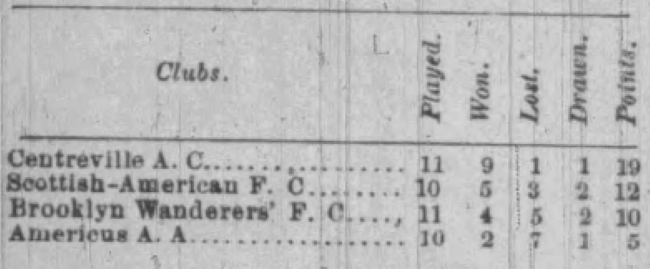
Week 13
Week 13 featured the May 26, 1895, battle for second place between the Scottish-Americans and Brooklyn Wanderers at Newark. In a lopsided affair, the Newark Daily Advertiser wrote the Scots “were outplayed at all points of the game by the strong defense of the Wanderers” and lost by the score of 8-4.[52] Gemmill, Brown, Hopkins, Mason (2), Young (2), and Hill scored for the Wanderers, and Wallace and McGee each scored a brace for the Scots. Lineups for the match are not available.
The Newark Evening News reported an 8-5 scoreline for the match but added more detail on events surrounding the contest. The kickoff was delayed by a baseball game taking place on the same grounds, which resulted in several of the Scots’ best players leaving Wiedenmayer’s Park before the start of play. Despite the delayed start, the Wanderers were prepared to play and “wanted to claim the game.” Absent several starters, the Scots “put in a scrub team and played what they assert was an exhibition game.”[53] If a dispute later arose over whether or not the match was an exhibition game, no newspaper accounts have been found to document it and it appears the Wanderers were awarded the contest. It was the last game the Scottish-Americans would play in the inaugural NAFL season.
The Centreville and Americus clubs rounded out the fixture list with a meeting on May 26 at Bayonne. Americus failed to appear, and the game was awarded to Centreville.
On May 30 the Brooklyn Wanderers faced Centreville for a non-NAFL football contest at the massive Decoration Day carnival of sports staged at the New Jersey Athletic Club grounds in Bergen Point. With goals from John Grundy and Charles Gorevin, Centreville again proved their dominance with a 2-0 victory that was never in doubt according to reports from the New York Evening World. Earlier in his career back in Scotland, Charles Gorevin, had the distinction of playing in the first-ever Glasgow Celtic match on May 28, 1888.[54]
Reminiscent of the atmosphere created by vuvuzelas 115 years later at the 2010 World Cup in South Africa, the World reported the Wanderers, “in their maroon and white football suits…were greeted by a Brooklyn contingent armed with long tin horns, which deafened the spectators, with a series of ecstatic toots every time one of their champions put the ball into play.”[55]
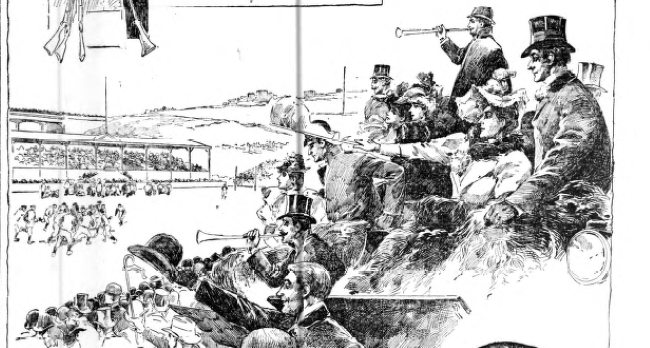
Weeks 14 and 15
Of the final three games played over the last two weeks of the season, two resulted in forfeits. The result for the remaining game can only be pieced together from final won/loss records. As usual, away teams proved the most likely to forfeit, with the visiting Scottish-Americans disappointing twice during this period. Results for the Week 14 and 15 games are as follows:
- June 2 – Americus AA vs. Brooklyn Wanderers at West Hoboken: Victory by Americus. (Winner implied from final won/lost records. Actual scoreline is unknown.)
- June 2 – Centreville AC vs. Scottish-Americans at Bayonne: Victory by Centreville AC due to Scottish-American forfeit.
- June 9 – Americus AA vs. Scottish-Americans at West Hoboken: Victory by Americus AA due to Scottish-American forfeit.
Centreville, the beneficiary of forfeits in their final two league contests, was rightly angry. The New York Sun wrote that “the Centrevilles and a large crowd of spectators were greatly disappointed. While the default of the two clubs added victories by forfeit to the Centreville’s league record, the Centrevilles and their partisans are highly indignant over the treatment accorded the Bayonne club by the West Hoboken and Newark organizations.”[56] Another black eye for the sport.
The first NAFL season now concluded with a whimper, the New York Sun posted the final standings and christened Bayonne Centreville AC champions of the inaugural season. The Brooklyn Wanderers and Newark Scottish-Americans had each finished with the same number of points, but the Sun reported the Scottish-Americans had disbanded, and “as they are indebted to the league, they will be disqualified and the place awarded to the Brooklyn Wanderers.” Americus finished in fourth place, making up ground during the late-season chaos.
The Sun reported that, as promised, the winning club was to “receive a handsome silver cup and each player presented with a gold medal.” Silver medals were to be awarded to the runners-up. Even though there was money in the treasury to cover the cost of the medals, to ensure the medals were “of a substantial kind the league suggested playing of an exhibition match on June 16, with proceeds going to the league.”[57]
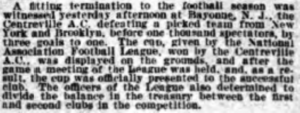
The exhibition fundraiser pitted inaugural league champion Centreville AC against a picked team from New York and Brooklyn. With the new “very handsome” trophy on display, a crowd estimated between 700 and 1000 was on hand in Bayonne to witness Centreville defeat the picked team 3-1.[58] George Spaven, Frederick Oliver, and James Fitzpatrick scored for the champions.
After the game the cup was formally awarded to Centreville. The Herald reported that “the officers of the League also determined to divide the balance in the treasury between the first and second clubs in the competition.”[59] Considering how the regular season concluded, it was a wise decision by league officials to conduct this exhibition and end on a positive, celebratory note. Final league business was conducted the following weeks at Bode’s, on Sixth Avenue, where medals were presented to Centerville and second-place Brooklyn Wanderers.[60]
1895 National Association Football League Final Standings
| Club | Won | Lost | Drawn | Points | Goals For* | Goals Against* |
| Centreville AC | 11 | 1 | 1 | 23 | 53 (53) | 21 (21) |
| Brooklyn Wanderers | 5 | 6 | 2 | 12 | 39 (42) | 43 (40) |
| Scottish-Americans | 5 | 6 | 2 | 12 | 29 (32) | 28 (32) |
| Americus AA | 4 | 8 | 1 | 9 | 14 (9) | 43 (43 |
* = Value Reported by New York Sun (value obtained from combined newspaper sources)
View more on the NAFL first season schedule and final standings · View NAFL season 1 scoring leaders
Born under a bad sign
The second season of the NAFL began with a slow start but eventually operated a more traditional winter/spring schedule from December 1895 to April 1896. Notable advances included amendment of the league by-laws to reflect the adoption of the penalty kick and the requirement for home sides to supply nets for matches. The Newark Scottish-Americans reformed and resolved their differences with the league to emerge as champions over John Grundy’s Bayonne Centreville. The troubles experienced in the first season of operation, however, would carry over into the second, and again only four teams finished out the season. New challenges were also encountered, including the increased scarcity of suitable grounds in urban centers and local protests over the playing of Sunday soccer.
Whitworth Southern’s Brooklyn Wanderers resigned from the league in December after being unable to secure grounds for league fixtures. W. E. Gill and Americus AA also did not participate in the second season, with the New York Sun writing that Americus “has decided to adhere strictly to its bona fide members this season and as its strength will be considerably reduced thereby, the association will resign from the league.”[61] Still active as an organization and still fielding a competitive club, the Americus kickers would operate more in line with Gill’s vision of eschewing league play and only participating in local “friendly” matches.
History shows the NAFL was born during a period of historic decline in US soccer. Gill experienced this firsthand and wrote in his manifesto that “there are not enough clubs or players, nor are there a sufficient number of interested spectators to make it [league play] a paying success, and if it is not a financial success it is a failure altogether.” This concept of a critical mass of players and fans is important when interpreting the events of the time.
The reason for the decline is complex. The Panic of 1893 plunged the nation into a period of depression that would not be seen again until the 1930s. Unemployment and homelessness rates skyrocketed, and a staggering number of businesses and banks failed. The Great Panic, however, may not tell the complete story as historical sources tend to agree that the effects of the panic lasted about five years. The impact of the panic was widespread, but certain areas with diversified industries thrived during that period. For example, the Buffalo Review stated that “Buffalo with so many industries, with her marvelous resources thrust on her by her geographical position, did not feel the panic. She was a Napoleon, that went on and never knew that the rest of the country was prostrate before an insidious enemy.”[62] Although the financial strain from the panic undoubtedly hurt the soccer “base” – urban mill workers (factory hands of Scotch or English birth) – the effects of the panic on immigration, combined with restrictions on immigration, is an important factor on why development of the game stagnated through the rest of the 1890s,
Soccer in the 1890s was truly a game of immigrants. This was evident most on the East Coast, were the game reached its highest levels of success but also apparent in other urban hotbeds like Chicago and Detroit. The link between immigration and prosperity has also been firmly established, with the New York Evening World commenting in 1903, “Exceptional immigration figures are always proof of exceptional prosperity.”[63] However, soccer during this period depended not just on immigrants – but as Roger Allaway describes in Rangers, Rovers, and Spindles – immigrants that brought soccer traditions with them.[64] At this time that would mean immigrants primarily from Great Britain.
In the midst of a period of high immigration, the Fall River Globe commented in 1908 that “people in far-away foreign countries have some mysterious method of learning what is transpiring in the United States” and that “nobody seems to be able to explain just how the knowledge of improved conditions found its way even into the remote districts of Russia.”[65] Conversely, news of America’s poor economic conditions in the 1890s also spread across the globe.
Mobility is not a one-way street. The Wall Street Journal observed in 1910, “in times of shortage in demand for labor there is always heavy emigration, as the cost of living is so much less in most European countries that it pays those that are out of work to return to their native lands and await the resumption of prosperity in this country.”[66] Proof of this was shown in New York in 1893, where the Elmira Star Gazette reported, “Emigration from this port [New York] has for the past six weeks…exceeded immigration…[S]uch a state of affairs had not been known in the recent history of this country.”[67]
The NAFL struggled through another three seasons before eventually collapsing in late 1899. Better economic conditions by the mid-1900s led to greater immigration, which saw the beginnings of soccer’s resurgence in the US. This, aided by the attention garnered by the successful tours of the Pilgrims (1905) and Corinthians (1906), fueled soccer’s burgeoning in the middle of the first decade of the Twentieth century. And this time, the critical mass of players and supporters was much greater than soccer’s first flowering in the United States between the mid-1880s and mid-1890s. The AFA Cup tournament resumed in 1906 and soon James Adams, the ex-Hearts defender turned manager of Newark FC, called to order the meeting that re-established the NAFL after a 7-year hiatus. This second version of the NAFL developed to be one the nation’s top leagues until it was eclipsed by the founding of the American Soccer League in 1921.
Notes
[1] “A New League Opens Its Campaign,” New York Sun, Monday, March 4, 1895, 6.
[2] “Centrevilles Beat Wanderers,” The New York Times, Monday, March 4, 1895, 16.
[3] “National Association Game,” The Brooklyn Daily Standard Union, Monday, March 4, 1895, 8.
[4] “Football Players Meet,” New York Sun, March 6, 1895, 8.
[5] “Standing of the Football Clubs,” New York Sun, Tuesday, March 12, 1895, 4.
[6] “Football Men In Session,” New York Sun, Saturday, March 16, 1895, 9.
[7] “Yacht Clubs Are Ready,” Brooklyn Daily Eagle, March 17, 1895, 4.
[8] “For Football Field Fame,” The Bayonne Times, March 14, 1895, 2
[9] “Centrevilles Defeat Internationals,” Brooklyn Daily Eagle, March 18, 1895, 4.
[10] ”Football Men Settle Disputes,” The New York Sun, March 23, 1895, 9.
[11] ”Football Men Settle Disputes,” 9.
[12] “Football Men Settle Disputes,” New York Sun, March 23, 1895, 9.
[13] “Centrevilles Outkick the Americus AA,” New York Sun, Monday, March 25, 1895, 6.
[14] “Football Men In Session,” New York Sun, Saturday, March 30, 1895, 6.
[15] “Football Notes,” New York Sun, December 11, 1894, 4.
[16] “Football Men In Session,” New York Sun, Saturday, March 30, 1895, 6.
[17] “Scottish-Americans Defeat the Centreville AC,” New York Sun, April 1, 1895, 6.
[18] Steve Grundy, Ancestry messages to Kurt Rausch, November 18, 2022.
[19] “U. S. A. Football Association Council,” The Brooklyn Daily Eagle, December 8, 1913, 19.
[20] “Newark Kickers Won,” The World (New York), April 8, 1895, 6.
[21] “Sports Of All Sorts,” Newark Evening News, April 8, 1895, 9.
[22] “For Football Field Fame.” The Bayonne Times, April 18, 1895, 2. The obituary for George Spaven’s wife Minnie states that George was sent by the U. S. Government to help bring American sanitation to the institutions of Cuba in 1898 following the Spanish American War. He moved on to become the sanitation inspector for the Island of Puerto Rico and established his own successful plumbing business. (“Mrs. George Spaven,” The Bayonne Times, October 14, 1941, p2, and “George Spaven Dies Suddenly,” The Bayonne Times, November 9, 1943, p1) Spaven would also arrange tours for Jersey City baseball clubs to Puerto Rico upon his many visits back to Northern New Jersey. (“Wants to Take Baseball Teams to Porto Rico,” The Bayonne Review, June 13, 1917, p3)
[23] “Football Men Meet,” New York Sun, April 14, 1895, 5
[24] “Football Men Meet,” 5.
[25] “Centrevilles The Champions,” New York World, April 14, 1895.
[26] ”Football Men Meet,” 5.
[27] “Association Football at Bayonne,” New York Daily Tribune, Monday, April 15, 1895, 3.
[28] “Newark Kickers Beaten,” Newark Evening News, April 15, 1895.
[29] “For Football Field Fame.” The Bayonne Times, April 18, 1895, 2.
[30] “Americus, 2; Wanderers, 1,” The New York Times, April 15, 1895, 6.
[31] “Americus AA Kick Out A Victory,” New York Sun, Monday, April 15, 1895, 6.
[32] “Association Football Matters,” New York Daily Tribune, April 21, 1895, 7.
[33] “Centrevilles Win Again,” The Jersey City News, Monday, April 22, 1895; “Battles With Ball and Bat.” The Bayonne Times, April 25, 1895, 1.
[34] “Sporting News In Brief,” The New York Times, Thursday, April 25, 1895, 6.
[35] “Foot Ball Players Kicking,” The Newark Evening News, Monday, April 22, 1895, 9. For more on contests between local American teams and steamship elevens, see Ed Farnsworth, “Sailor lads, jolly tars, and rovers of the briny deep: International ship-crew soccer matches in the US, 1890-1905, part 1,” Society for American Soccer History, last modified June 16, 2022, https://www.ussoccerhistory.org/sailor-lads-jolly-tars-and-rovers-of-the-briny-deep-international-ship-crew-soccer-matches-in-the-us-1890-1905-part-1/
[36] “Wanderers, 6; Scottish-Americans, 4,” The New York Times, Monday, April 22, 1895, 6.
[37] “Football Notes,” The Paterson Call, April 19, 1895.
[38] “Association Football Games,” The New York Times, April 29, 1895, 6; “Two Games of Football In the National League Series,” The New York Sun, April 29, 1895, 6.
[39] “Association Football Games,” The New York Times, April 29, 1895, 6
[40] “Local Football Kickers Win,” The Newark Evening News, April 29, 1895, 9.
[41] “The Scots Win At Football,” The Newark Evening News, May 6, 1895, 9.
[42] “Football for the National A. F. L. Championship,” New York Sun, May 6, 1895, 7.
[43] “Constitution, By-Laws and Laws of the Game of the American Football Association,” Peck and Synder, 1888.
[44] “Hot Weather Football,” Newark Sunday Call, May 12, 1895.
[45] “The Association Football Championship,” New York Daily Tribune, May 13, 1895, 5.
[46] “Logan lost the Game,” The New York Times, October 17 1894, 3.
[47] “The Association Football Championship,” 5.
[48] “Foot Ball Kicks,” Newark Evening News, May 13, 1895, 9.
[49] “For Football Field Fame,” The Bayonne Times, May 23, 1895, 2.
[50] “For the National A. F. L. Championship,” New York Sun, May 20 1895, 9.
[51] “Scottish Americans, 6; Americus, 0.,” The New York Times, May 20, 1895, 6.
[52] “Newarkers Defeated,” Newark Daily Advertiser, May 27, 1895.
[53] “With the Foot Ball Players,” Newark Evening News, May 27, 1895.
[54] “The First Sligo Man To Play For Glasgow Celtic: Charlie Gorevin,” Sligo Weekender, www.pressreader.com/ireland/sligo-weekender/20220120/282368338017174, Accessed July 23, 2023.
[55] “Orton Wins From Conneff,” New York Evening World (Night Edition), May 30, 1895, 1.
[56] “Bayonne Footballers Disappointed, New York Sun, June 3, 1895, 8.
[57] “Season of the National Association Football League,” The New York Sun, June 16, 1895, 8.
[58] “Centrevilles Win at Football,” The New York Times, Monday, June 17, 1895, 6; “Centreville Kickers Wind Up the Season with a Victory,” The New York Sun, Monday, June 17, 1895, 9.
[59] “Live Sporting Notes,” The New York Herald, Monday, June 17, 1895, 8.
[60] “Football League Presents Medals,” New York Daily Tribune, June 27, 1895, 9.
[61] “Dribblers Slow To Begin,” The New York Sun, November 3, 1895, 9.
[62] “Panic of 1893,” The Buffalo Review, Monday, January 30, 1899, 1.
[63] “Our New Citizens,” The New York Evening World, May 3, 1902, 6.
[64] Roger Allaway, Rangers, Rovers, and Spindles: Soccer, Immigration, and Textiles in New England and New Jersey (Howarth, NJ: St. Johan Press, 2005), xi – xiv.
[65] “Rush of Immigration,” The Fall River Globe, December 23, 1908, 4.
[66] “Tide of Labot This Way,” The Wall Street Journal, February 21, 1910, 6.
[67] “Emigration Exceeding Immigration,” The Elmira Star-Gazette, September 12, 1893, 1
